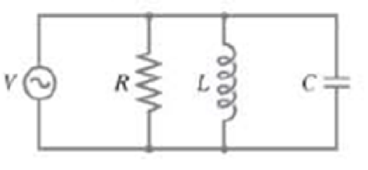
A resistor R, capacitor C, and inductor L are connected in parallel across an ac generator as shown in Fig. 30–34. The source emf is V = V0 sin ωt. Determine the current as a function of time (including amplitude and phase): (a) in the resistor, (b) in the inductor, (c) in the capacitor, (d) What is the total current leaving the source? (Give amplitude I0 and phase) (e) Determine the impedance Z defined as Z =V0/I0). (f) What is the power factor?
FIGURE 30–34
Problem 93.

93.
(a) Since the three elements are connected in parallel at any given instant in time they will all three have the same voltage drop across them. That is the voltages across each element will be in phase with the source. The current in the resistor is in phase with the voltage source with magnitude given by Ohm’s law.
(b) The current through the inductor will lag behind the voltage by π/2, with magnitude equal to the voltage source divided by the inductive reactance.
(c) The current through the capacitor leads the voltage by π/2, with magnitude equal to the voltage source divided by the capacitate reactance.
(d) The total current is the sum of the currents through each element. We use a phasor diagram to add the currents, as was used in Section 30-8 to add the voltages with different phases. The net current is found by subtracting the current through the inductor from the current through the capacitor. Then using the Pythagorean theorem to add the current through the resistor. We use the tangent function to find the phase angle between the current and voltage source.
(e) We divide the magnitude of the voltage source by the magnitude of the current to find the impedance.
(f) The power factor is the ratio of the power dissipated in the circuit divided by the product of the rms voltage and current.
Want to see the full answer?
Check out a sample textbook solution
Chapter 30 Solutions
Physics for Scientists and Engineers with Modern Physics
Additional Science Textbook Solutions
Campbell Essential Biology with Physiology (5th Edition)
Campbell Biology (11th Edition)
Organic Chemistry (8th Edition)
Microbiology: An Introduction
Cosmic Perspective Fundamentals
Anatomy & Physiology (6th Edition)
- At s1iat frequency is the reactance of a 20F capacitor equal to that of a 10-mH inductor?arrow_forwardIn an oscillating LC circuit, the maximum charge on the capacitor is qm. Determine the charge on the capacitor and the current through the inductor den energy is shared equally between the electric and magnetic fields. Express your answer in terms of qm, L, and C.arrow_forwardIn an LC circuit, what determines the frequency and the amplitude of the energy oscillations in either the inductor or capacitor?arrow_forward
- Calculate the rms currents for an ac source is given by v(t)=v0sint , where V0=100V and =200rad/s when connected across (a) a 20F capacitor, (b) a 20-mH inductor, and (c) a 50 resistor.arrow_forwardA series RLC circuit is driven in such a way that the maximum voltage across the inductor is 1.50 times the maximum voltage across the capacitor and 2.10 times the maximum voltage across the resistor. (a) What is o for the circuit? The resistance is 51.8 Q and the current amplitude is 150 mA. (b) What is the amplitude of the driving emf? (a) Number i Units (b) Number i Unitsarrow_forwardConsider a 10W, a 50µF capacitor and a 80mH inductor connected in series across a standard outlet. (a) By what angle is the voltage ahead of the current in this circuit?(b) What is the rms voltage across the capacitor?(c) What is the power dissipated in the inductor (only the inductor), in the capacitor and in the resistor? There are three answers?arrow_forward
- The emf of an ac source is given byv(t) = V0sin ωt, where V0 = 100 V andω = 200π rad/s. Calculate the average power output ofthe source if it is connected across (a) a 20-µF capacitor,(b) a 20-mH inductor, and (c) a 50-Ω resistor.arrow_forwardstep by step plzarrow_forwardi) A 100 Q resistor, a 1.55439 H inductor, and 2.9 uF capacitor are connected in series with an AC source. If the capacitive reactance is equal to the inductive reactance of the circuit, estimate: (a) the frequency of the source and (b) the impedance of the circuit.arrow_forward
- A sinusoidal voltage of 20.0 V rms and a frequency of 100 Hz is applied separately to three different components: first to a 300-Ω resistor, then to a 0.400-H inductor, and finally to a 50.0-μF capacitor. Calculate the maximum current ?R,max through the resistor Calculate the average power PR,average delivered to the resistor. Calculate the maximum current iL,max through the inductor. Calculate the average power ?L,average delivered to the inductor. Calculate the maximum current ?C,max through the capacitor. Calculate the average power ?C,average delivered to the capacitor.arrow_forwardDetermine the current on the capacitor at any time t > 0 in a circuit in series having an emf given by t, when 0 T a resistor of 6 ohms and an inductor of 2 H, if i(0) = 0. %3Darrow_forwardIn the figure, an ac generator with emf E = Em sin wat, where Em = 25.1 V and wa = 376 rad/s, is connected to a 4.41 UF capacitor. (a) What is the maximum value of the current? (b) When the current is a maximum, what is the emf of the generator? (c) When the emf of the generator is - 12.2 V and increasing in magnitude, what is the current? (a) Number i Units (b) Number i Units (c) Number i Unitsarrow_forward

 Glencoe Physics: Principles and Problems, Student...PhysicsISBN:9780078807213Author:Paul W. ZitzewitzPublisher:Glencoe/McGraw-Hill
Glencoe Physics: Principles and Problems, Student...PhysicsISBN:9780078807213Author:Paul W. ZitzewitzPublisher:Glencoe/McGraw-Hill

